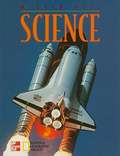- Table View
- List View
Macmillan McGraw-Hill Science
by Richard H. Moyer Joanne Vasquez Jay Hackett Pamela Stryker H. Prentice Baptiste Lucy H. DanielExtensively dealing with the subject of Science, this book covers Life Science, Physical Science and Earth Science.
McGraw-Hill Science (Grade 2, Texas Edition)
by Richard H. Moyer Joanne Vasquez Jay Hackett Pamela Stryker H. Prentice Baptiste Lucy H. DanielThe Texas edition of this science text book for Grade 2 contains unit lessons on Watering Earth Planets, Clues from the past, Changes all around, Watch it move, Rocky Homes, Human Body: Heart and Lungs, and also Your Text Book at a Glance, National Geographic invitation to Science, Be a Scientist and Texas Topics.
Mcgraw - Hill Science (Grade 4, Texas edition)
by Lucy Daniel Joanne Vasquez Jay Hackett Richard Moyer Pamela Stryker Prentice BaptisteScientists study books and articles to find out facts. They also ask questions. They always try to test their ideas for themselves.
McGraw-Hill Science (Grade 5, Texas edition)
by Lucy Daniel Joanne Vasquez Jay Hackett Richard Moyer Pamela Stryker Prentice BaptisteScientists are curious about the world around them. This curiosity causes them to ask questions about things they don't understand. Sometimes they question the explanations accepted by others.
Science (California Edition)
by Lucy Daniel Joanne Vasquez Jay Hackett Richard Moyer Pamela Stryker Prentice BaptisteBegin each topic with an Explore question. Then try an Explore Activity Read the Science Magazines. National Geographic World of Science is the first magazine in each unit. Answer fun questions about real-world facts Have fun solving Problems and Puzzles. Write in the Science Journal about what you learn Build your skills with Skill Builders. Use the Handbook for help.
McGraw- Hill Science
by Lucy Daniel Joanne Vasquez Jay Hackett Richard Moyer Pamela Stryker H. Prentice BaptisteLearn more about what scientists do, and how you can explore the world through science yourself!
McGraw Hill Science: Grade 2
by Mcgraw HillThe three major topics covered in this book are Life, Earth and Physical Science.
McGraw Hill Science 3rd Grade
by Lucy Daniel Joanne Vasquez Jay Hackett Richard Moyer Pamela Stryker H. Prentice BaptisteGeneral science textbook.
Science
by McGraw-HillScience textbook. As you read, you'll learn about the Methods of Science, the steps scientists follow to solve problems.
McGraw-Hill Science
by Richard H. Moyer Joanne Vasquez Jay Hackett Pamela Stryker H. Prentice Baptiste Lucy H. DanielTopics broadly covered in this book are life science, earth science, physical science motion, work, and machines.
McGraw-Hill Science Unit F: Motion and Energy
by Richard H. Moyer Joanne Vasquez Jay Hackett Pamela Stryker H. Prentice Baptiste Lucy H. DanielThis Unit F on Physical Science--Motion and Energy-- contains Newton's Laws of Motion, Sound Energy and Light Energy.
McGraw-Hill Science: Properties of Matter and Energy
by Lucy Daniel Joanne Vasquez Jay Hackett Richard Moyer Pamela Stryker Prentice BaptisteThis book covers everything about matter and energy e.g. their properties, what affects them etc.
McGraw-Hill Science Unit B: Interactions of Living Things
by Richard H. Moyer Jay Hackett Pamela Stryker H. Prentice Baptiste Lucy H. Daniel Jo Anne VasquezUnit B of McGraw-Hill Science.
Physical Science, Unit E: Interactions of Matter and Energy
by Lucy Daniel Joanne Vasquez Jay Hackett Richard Moyer Pamela Stryker H. Prentice BaptisteAn introductory science text.
McGraw-Hill Science: Observing The Sky 6th Grade
by Lucy Daniel Joanne Vasquez Richard Moyer Pamela Stryker Jay Hackett H. Prentice BaptisteThe branch of science that deals with "what's up there" is astronomy. Astronomy is the study of the universe. The universe is everything that exists--Earth and all the things in space. The contents of space include the planets, stars, and galaxies.
McGraw-Hill Science 6th Grade, Unit B: Organization of Living Things
by Lucy Daniel Joanne Vasquez Jay Hackett Richard Moyer Pamela Stryker H. Prentice BaptisteThis book deals with lessons on Cells and Inheriting Traits.
McGraw Hill Science (Grade 1, Tennessee Edition)
by Richard H. Moyer Joanne Vasquez Jay Hackett Pamela Stryker Prentice Baptiste Lucy H. DanielThis book covers science in three units: life science, earth science and physical science.
McGraw-Hill Science (Grade 2, Tennessee Edition)
by Lucy Daniel Joanne Vasquez Jay Hackett Richard Moyer Pamela Stryker Prentice BaptisteScience textbook for 2nd graders in Tennessee.
Macmillan McGraw-Hill Science 3rd Grade
by Lucy Daniel Joanne Vasquez Jay Hackett Richard Moyer Pamela Stryker H. Prentice BaptisteThis textbook goes into broad details on life, earth and physical science.
McGraw Hill Science (Tennessee Edition)
by Richard H. Moyer Jay Hackett Lucy H. Daniel H. Prentice Baptiste [et al.]An edition that instills scientific knowledge on its readers in an interesting yet knowledgeable way; you will learn many new words that means new ideas with image descriptions that will help you understand what you are reading.
McGraw-Hill Science 5th Grade: Tennessee Edition
by Richard Moyer Mcgraw-Hill StaffA general science book for fifth grade students.
Health & Wellness (California Editon) 4th Grade
by Linda Meeks Philip HeitA program designed to teach children how to make healthy life choices.
McGraw Hill Science, Grade 4
by National Geographic Society Macmillan Mcgraw-HillThis grade4 science covers lessons on 1. Life Science: The World of Living Things; Animals as Living Things, 2.Earth Science: Earth and Beyond; Water and Weather, 3.Physical Science: Matter; and Energy.

